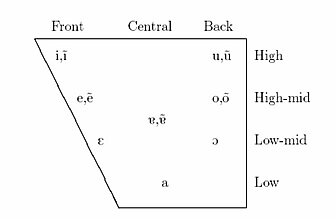PORTUGUESE VOWELS
Portuguese has one of the notable vowel phonologies of all Romance languages. In Brazil has seven oral vowels and in Portugal has nine oral vowels; five nasal vowels, ten oral diphthongs, and five nasal diphthongs. The high vowels /e o/ and the low vowels / / are four separate phonemes, different in Portuguese, and the contrast between them is used for vowel alternation.
/ are four separate phonemes, different in Portuguese, and the contrast between them is used for vowel alternation.
The vowel record of Brazilian Portuguese includes eight sounds of different quality. Of these, there are seven major vowels that can appear in stressed positions ([i e a
a  o u]) and one vowel that is always unstressed. Two approximants permit for all permutations of the major vowels as diphthongs and some instances of triphthongs. Additionally, nasalization can occur with any type of vowel and is a salient phonemic difference.
o u]) and one vowel that is always unstressed. Two approximants permit for all permutations of the major vowels as diphthongs and some instances of triphthongs. Additionally, nasalization can occur with any type of vowel and is a salient phonemic difference.
The major vowels are symmetrically distributed on a standard vowel diagram: three front vowels, two central vowels, and three back vowels. The three back vowels are rounded. The figure illustrates the relative positions of the Portuguese vowels.

The vowel of Brazilian Portuguese
 / are four separate phonemes, different in Portuguese, and the contrast between them is used for vowel alternation.
/ are four separate phonemes, different in Portuguese, and the contrast between them is used for vowel alternation.The vowel record of Brazilian Portuguese includes eight sounds of different quality. Of these, there are seven major vowels that can appear in stressed positions ([i e
 a
a  o u]) and one vowel that is always unstressed. Two approximants permit for all permutations of the major vowels as diphthongs and some instances of triphthongs. Additionally, nasalization can occur with any type of vowel and is a salient phonemic difference.
o u]) and one vowel that is always unstressed. Two approximants permit for all permutations of the major vowels as diphthongs and some instances of triphthongs. Additionally, nasalization can occur with any type of vowel and is a salient phonemic difference.The major vowels are symmetrically distributed on a standard vowel diagram: three front vowels, two central vowels, and three back vowels. The three back vowels are rounded. The figure illustrates the relative positions of the Portuguese vowels.

The vowel of Brazilian Portuguese
 Diacritics Diacritics |
 Nasalization Nasalization |
 Diphthongs Diphthongs |
 Triphthongs Triphthongs |
© 2007-2022 All rights reserved
